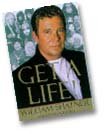 |
A Clearing in the Distance: Frederick Law Olmsted and North America
in the Nineteenth Century, Harper Flamingo Canada, 1999,
$35, by Witold Rybczynski, BArch'66, MArch'73.
Olmsted and Rybczynski are a perfect fit: the latter, a successful
popularizer of both the rarified world of urban and interior design,
and of the social consequences of modernity and architecture; the former,
a towering figure in progressive movements toward increased civility
in North American life, chiefly as the designer of New York's Central
Park and Montreal's Mount Royal Park, among many others.
Like all of Rybczynski's popular books - including Home (1987), Looking
Around: A Journey through Architecture (1993), and City Life (1996)
- this current volume is simply and clearly written, frequently evoking
"common-sense" conclusions about the heady cultural phenomena which
swirled around nineteenth-century America. This earnest feature of the
book, one which aligns it all the more closely with Olmsted's own practical
simplicity, is at once the book's strength and its only weakness.
Rybczynski, a former McGill architecture professor who teaches now
at the University of Pennsylvania, writes in a style which is especially
well suited to the book's first purpose - as straight-ahead biography
of an important man. Olmsted, best known as a landscape architect whose
astonishingly long view of history has resulted in dozens of gorgeous
urban parks, was also co-founder of The Nation magazine, first general
secretary to the U.S. Sanitary Commission (precursor to the Red Cross),
and an acquaintance of a wide range of thinkers, including proto-environmentalist
George Geddes, and writers Thoreau, Emerson and Hawthorne. Olmsted's
intersections with these luminaries are recounted with precision, and
easily interwoven with standard but necessary biographical details about
his education, family, ailments, and so on.
However, Rybczynski's brief account of Olmsted's ruthless dealings
with a strike at the goldmine he once managed provides an example of
how the tendency toward clarity can unfortunately result in oversimplification.
Olmsted arbitrarily imposed a ten-percent wage reduction (which Rybczynski
calls "slight"), then summarily dismissed all his employees when they
struck in protest. Rybczynski's glib justification for these actions
is far too simplistic, under the facile premise that there were no other
alternatives. "He did what any conscientious manager of a troubled enterprise
must do: he trimmed labor costs."
If A Clearing in the Distance is somewhat lacking in its analysis of
North America in the last century, it remains superb as biography -
a condition helped considerably by its fascinating subject's broad interests.
Peter Urquhart, PhD'01
Peter Urquhart has studied the history and culture
of the late nineteenth century in the course of research and teaching
at McGill and at Champlain College.
|
 |
Bulldog: Spirit of the New Entrepreneur,
HarperBusiness, 1999, $26, by Ellie Rubin, BA'85.
A study published recently in Report on Business magazine says 16%
of working Canadians are in business for themselves, up from 10% in
the early 1990s. According to Ellie Rubin, that number could increase
dramatically. In her book she quotes a survey conducted among 20-somethings,
87% of whom said they would rather own their own business than work
for someone else. These new wannabe entrepreneurs have a lot to learn,
says Rubin, especially if they plan to compete in the high-tech field.
As co-founder of The Bulldog Group, a very successful media management
software company with clients like Sony Pictures and General Motors,
Rubin knows what it takes.
Once portrayed as a hard-nosed, driven and unconventional loner - usually
male - the new entrepreneur must be willing to learn constantly, to
seek partnerships and to navigate through a landscape where change is
rapid enough to cause whiplash. In what she calls a "book of mini-revelations,"
Rubin outlines her successes - and mistakes - in finding partners, investors,
champions and a "brand" for Bulldog. The company started as a marketing
and design service business, although the partners always knew that
they wanted to become a software product company. They just had no idea
for the first few years what that product should be.
Bulldog: Spirit of the New Entrepreneur is a loosely woven account
of that evolution, and how she and her staff maintained a vision through
continuing shifts in the firm's direction. The book's pieces - short
anecdotes and bits of advice - can become dizzying if taken in big chunks.
The "two most important things to remember" become "the four steps to
success" which "happen in these three stages" and "require people with
the following six qualities," etc. Occasionally, the new entrepreneurial
jargon becomes a little tedious - verbs like "productize" and phrases
like "relentless convergence," "independent percolation" and "reality
matrix."
But some insights are valuable and clearly communicated. To entrepreneur
(yes, that's a verb now) still takes "desire, desire, desire" and those
who do it successfully may be, as Rubin describes Martha Stewart, "strange,
courageous, irreverent and not so comfortable friends." Rubin issues
a warning: "If one person in the family is entrepreneuring, the rest
of the family has to understand that taking a chance on a company really
means taking a chance on everything, including family life." She adds
that if entrepreneurs or their family and friends think that life will
return to normal once the "big happy" (a specific sales target, for
example) has been reached, they are deluding themselves. People change
in the course of building a business and for the true obsessive, no
milestone is ever the last. That drive is often criticized, but Rubin
says a life of "healthy imbalance" can work for those who need the exhilaration
and for whom "a half day means leaving at 5 o'clock." For many, though,
entrepreneuring may be just too risky a business.
Diana Grier Ayton
|
 |
Get a Life!, Pocket Books, $35.50, by William Shatner,
BCom'52, with Chris Kreski.
Star Trek anthropologists are having a banner year. The documentary
film Trekkies kicked it off with a hilarious if vaguely frightening
glimpse into the world of the hardcore Star Trek fan. William Shatner's
latest book, Get a Life! delves even deeper into the Trek psyche
in a lighthearted account of the actor's personal five-year mission
to understand the people who have made him a pop-culture icon.
Get a Life! provides a Kirk's eye view of the birth and short
life of the original TV series. As Shatner explains, the real Star Trek
phenomenon began only after the show went into syndication and fans
began mobilizing. He interviews organizers of the first Trek conventions,
ending up with a fascinating tale of how raw enthusiasm for an "expensive,
prime-time flop" mushroomed into a nationwide mania within a year.
Conspicuously absent from the hordes of early Trek aficionados was
Shatner himself. "I just didn't 'get it,'" he writes, referring to the
entire phaser and pointy-ear crowd. Then, about five years ago, Shatner's
career and personal life fell apart. The actor suddenly found himself
with a new appreciation for and curiosity about the one constant in
his life - his fans.
So he told his agent to "say yes to everything" and embarked on his
"Kirkapalooza" tour. He set about interviewing fans, cast members, dealers
and organizers at conventions worldwide. "What was it about Star Trek
that inspires such devotion?" he writes. "How come nobody ever dresses
up like Jack Tripper and has a Three's Company convention? What was
the big deal, anyway?"
Get a Life! blends more serious moments with healthy doses of
humour, including Shatner impersonation tips from comedian and master
Kirk imitator Kevin Pollak. And we finally learn the explanation for
Kirk's trademark bizarre pauses ...between ...words! Shatner often couldn't
remember his next line - the dramatic pauses were just an actor stalling
for time.
Despite a relentlessly self-deprecating style that rings hollow at
times, Shatner's account of his gradual conversion to Trekkie comes
across as genuine. In the end, he seems to understand and like the people
he's met on his quest. Perhaps in atonement for his original "Get a
life!" - Shatner's now-famous scolding of an obsessive Star Trek fan
in a Saturday Night Live skit - he addresses the stereotype of the "Star
Trek geek" head-on. The show's portrayal of a world where acceptance
and equality are the norm, he argues, naturally attracts people who
feel they're not fully accepted or equal in this world.
Although Get a Life! provides an interesting glimpse into the strange
life of a celebrity actor, its lasting impact comes from the poignant
stories and musings of the show's fans. In the end, Shatner's interviews
make a strong case that the phenomenal popularity of Star Trek wasn't
an inexplicable fad. The show did have a message. And remarkably, despite
its cheesy papier-mâché monsters, scantily clad space sirens
and William Shatner's eccentric acting, the message got through.
Owen Egan, BA'87
Works Received
Do We Care? Renewing Canada's Commitment to Health, McGill-Queen's
University Press, 1999, $19.95, edited by Margaret Somerville, DCL
'78.
This book is based on a 1998 conference held in Toronto to provide
a forum for "transdisciplinary conversations" on the issue of directions
for Canadian health care. Edited by one of the most esteemed scholars
and sought after commentators on health and the law, Do We Care? should
be of interest not solely to those directly involved in health policy
but to a wide cross-section of readers. As Somerville notes in her introduction:
"Health care is never simply about health care, and certainly not in
Canada. Our health care system defines us as communities, as a society,
and as a nation." For this reason, and certainly for the thoughtful
contributions by distinguished scholars, policymakers, and physicians,
including John Ralston Saul, BA'69, DLitt'97, Bob Rae and former McGill
Dean of Medicine Dr. Richard Cruess, this book is a must read for those
who do care.
Not Just to But Over the Moon, MoZo Records, Monik Nordine,
MMus'97.
Soprano sax player Monik Nordine comes to us with a debut effort of
original jazz, and it's quite a polished collection from this young
McGill jazz perform-ance graduate. Citing influences ranging from trumpeter
Kenny Wheeler to the trailblazing Ornette Coleman - with a little John
Coltrane and soprano sax player Steve Lacy thrown in for good measure
- Nordine is a fine player whose composition skills take a rather lyrical
bent, without being cloying. Perhaps the finest piece on the record
is the beautiful waltz-time title track, featuring tremendous soloing
from Nordine and, oddly enough, written to commemorate her graduation
from McGill ("a joyous event," she notes, though it's not clear how
this is to be taken). Other standouts include "How It Is," an upbeat
and swinging piece with great playing from pianist Alex Clements, MMus'97,
and the CD's modal opener, "Fives." Nordine and Clements are ably supported
by trumpeter Aron Doyle, BMus'95, bassist Tommy Babin, BMus'97, and
Claude Lavergne behind the drums.
Gabrielle Roy: A Life, McClelland and Stewart, 1999,
$39.99, by François Ricard, MA'68, translated by Patricia Claxton,
BA'51.
Upon its original French publication, this biography of the great Franco-Manitoban
writer was met with rave reviews and sold an impressive 25,000 copies.
Ricard, a professor of French language and literature at McGill, was
hailed as having produced the definitive work on Roy, whose best known
book, The Tin Flute, was described by The Globe and Mail as "the great
Canadian novel" when it was released in English. Ricard, a longtime
friend of Roy's, and Governor General's Award winner, takes advantage
here of both his scholarly expertise in French literature and of his
personal relationship with his subject to tell the story of a remarkable
life in sensitive detail. Translator Patricia Claxton is also familiar
with the author, having won a Governor General's Award herself for her
translation of Roy's autobiography.
|